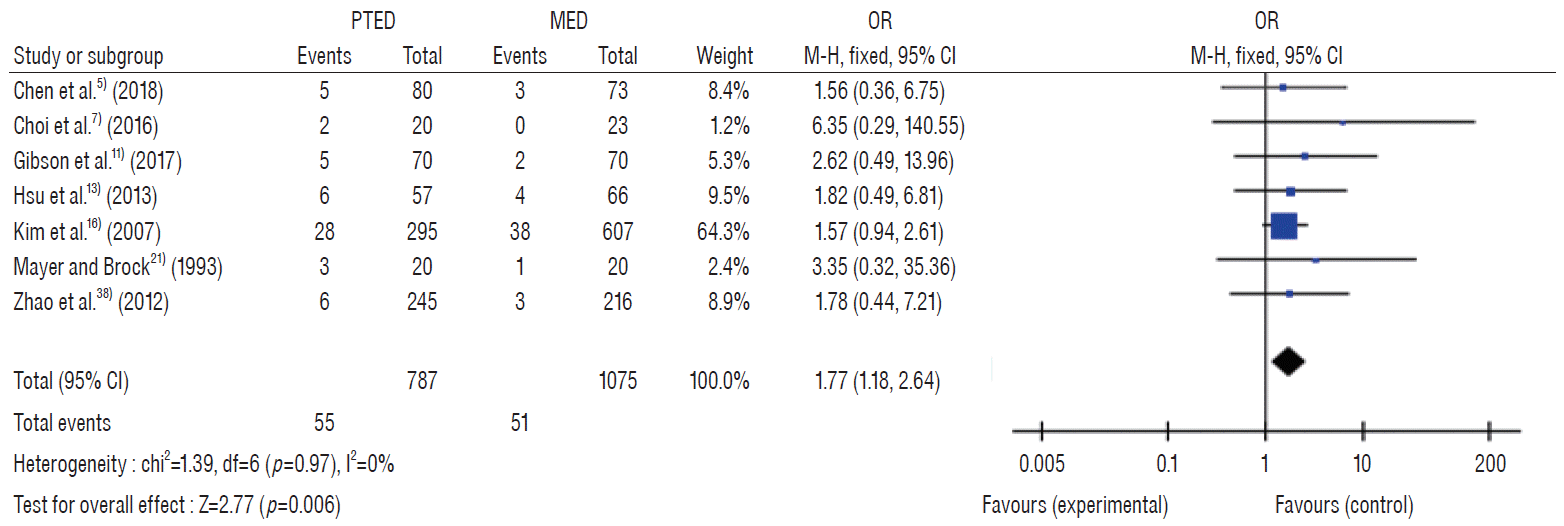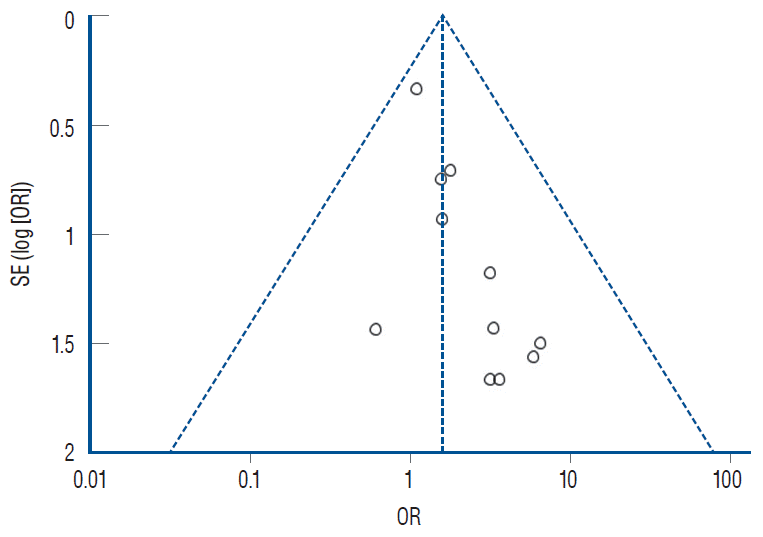1. Ahn SS, Kim SH, Kim DW, Lee BH. Comparison of outcomes of percutaneous endoscopic lumbar discectomy and open lumbar microdiscectomy for young adults: a retrospective matched cohort study. World Neurosurg. 86:250–258. 2016.

2. Ahn Y, Kim CH, Lee JH, Lee SH, Kim JS. Radiation exposure to the surgeon during percutaneous endoscopic lumbar discectomy: a prospective study. Spine (Phila Pa 1976). 38:617–625. 2013.

3. Ahn Y, Lee SH, Park WM, Lee HY, Shin SW, Kang HY. Percutaneous endoscopic lumbar discectomy for recurrent disc herniation: surgical technique, outcome, and prognostic factors of 43 consecutive cases. Spine (Phila Pa 1976). 29:E326–E332. 2004.

4. Chen GY, Xie E, Zhang ZX, Hao DJ, Fan Y, Li FH. Multiple factors influencing the postoperative recurrence of lumbar disc herniation treated with lumbar discectomy. Chin J Bone Joint. 6:437–441. 2018.
5. Chen Z, Zhang L, Dong J, Xie P, Liu B, Wang Q, et al. Percutaneous transforaminal endoscopic discectomy compared with microendoscopic discectomy for lumbar disc herniation: 1-year results of an ongoing randomized controlled trial. J Neurosurg Spine. 28:300–310. 2018.

6. Choi G, Kang HY, Modi HN, Prada N, Nicolau RJ, Joh JY, et al. Risk of developing seizure after percutaneous endoscopic lumbar discectomy. J Spinal Disord Tech. 24:83–92. 2011.

7. Choi KC, Kim JS, Park CK. Percutaneous endoscopic lumbar discectomy as an alternative to open lumbar microdiscectomy for large lumbar disc herniation. Pain Physician. 19:E291–E300. 2016.
8. Farace DJ, Frantzen J. Perspectives on the design and transfer of scientific and technical information : third international conference on grey literature. 1997 November 13-14; Luxembourg. Amsterdam. Grey Literature Network Service;1998. Mar. p. 294.
9. Fontanella A. Endoscopic microsurgery in herniated cervical discs. Neurol Res. 21:31–38. 1999.

10. Garg B, Nagraja UB, Jayaswal A. Microendoscopic versus open discectomy for lumbar disc herniation: a prospective randomised study. J Orthop Surg (Hong Kong). 19:30–34. 2011.

11. Gibson JNA, Subramanian AS, Scott CEH. A randomised controlled trial of transforaminal endoscopic discectomy vs microdiscectomy. Eur Spine J. 26:847–856. 2017.

12. Hou KD, Liu ZS, Zhu SR. A long-term follow-up study of the remote result of lumbar discectomy versus conservative treatment for single-level lumbar disc herniation. Med J Chin PLA. 37:727–730. 2012.
13. Hsu HT, Chang SJ, Yang SS, Chai CL. Learning curve of full-endoscopic lumbar discectomy. Eur Spine J. 22:727–733. 2013.

14. Kafadar A, Kahraman S, Akbörü M. Percutaneous endoscopic transforaminal lumbar discectomy: a critical appraisal. Minim Invasive Neurosurg. 49:74–79. 2006.

15. Kim CH, Chung CK, Park CS, Choi B, Kim MJ, Park BJ. Reoperation rate after surgery for lumbar herniated intervertebral disc disease: nationwide cohort study. Spine (Phila Pa 1976). 38:581–590. 2013.

16. Kim MJ, Lee SH, Jung ES, Son BG, Choi ES, Shin JH, et al. Targeted percutaneous transforaminal endoscopic diskectomy in 295 patients: comparison with results of microscopic diskectomy. Surg Neurol. 68:623–631. 2007.

17. Li H, Jiang C, Mu X, Lan W, Zhou Y, Li C. Comparison of MED and PELD in the treatment of adolescent lumbar disc herniation: a 5-year retrospective follow-up. World Neurosurg. 112:e255–e260. 2018.

18. Liu C, Chu L, Yong HC, Chen L, Deng ZL. Percutaneous endoscopic lumbar discectomy for highly migrated lumbar disc herniation. Pain Physician. 20:E75–E84. 2017.
19. Liu HN, Lin X, Yan JZ, Wang L, Cui W, Zeng Z. A comparison of preliminary surgical resu lts between percutaneous transforaminal endoscopic discectomy and microsurgical lumbar disc ectomy for lumbar disc herniation. Chin J Bone Joint. 2:30–35. 2013.
20. Liu X, Yuan S, Tian Y, Wang L, Gong L, Zheng Y, et al. Comparison of percutaneous endoscopic transforaminal discectomy, microendoscopic discectomy, and microdiscectomy for symptomatic lumbar disc herniation: minimum 2-year follow-up results. J Neurosurg Spine. 28:317–325. 2018.

21. Mayer HM, Brock M. Percutaneous endoscopic discectomy: surgical technique and preliminary results compared to microsurgical discectomy. J Neurosurg. 78:216–225. 1993.

22. Miller RG. The jackknife-a review. Biometrika. 61:1–15. 1974.

23. Mixter WJ, Barr JS. Rupture of the intervertebral disc with involvement of the spinal canal. New Eng J Med. 211:210–215. 1934.

24. Perez-Cruet MJ, Foley KT, Isaacs RE, Rice-Wyllie L, Wellington R, Smith MM, et al. Microendoscopic lumbar discectomy: technical note. Neurosurgery. 51(5 Suppl):S129–S136. 2002.

25. Qu JX, Li QZ, Chen M. Comparative study of PTED and MED for monosegment lumbar disc herniation. Chin J Bone Joint Inj. 32:70–71. 2017.
26. Richardson WS, Wilson MC, Nishikawa J, Hayward RS. The well-built clinical question: a key to evidence-based decisions. ACP J Club. 123:A12–A13. 1995.
27. Ruetten S, Komp M, Merk H, Godolias G. Full-endoscopic interlaminar and transforaminal lumbar discectomy versus conventional microsurgical technique: a prospective, randomized, controlled study. Spine (Phila Pa 1976). 33:931–939. 2008.

28. Schoeggl A, Maier H, Saringer W, Reddy M, Matula C. Outcome after chronic sciatica as the only reason for lumbar microdiscectomy. J Spinal Disord Tech. 15:415–419. 2002.

29. Sclafani JA, Kim CW. Complications associated with the initial learning curve of minimally invasive spine surgery: a systematic review. Clin Orthop Relat Res. 472:1711–1717. 2014.

30. Sinkemani A, Hong X, Gao ZX, Zhuang SY, Jiang ZL, Zhang SD, et al. Outcomes of microendoscopic discectomy and percutaneous transforaminal endoscopic discectomy for the treatment of lumbar disc herniation: a comparative retrospective study. Asian Spine J. 9:833–840. 2015.

31. Stang A. Critical evaluation of the Newcastle-Ottawa scale for the assessment of the quality of nonrandomized studies in meta-analyses. Eur J Epidemiol. 25:603–605. 2010.

32. van Tulder M, Furlan A, Bombardier C, Bouter L; Editorial Board of the Cochrane Collaboration Back Review Group. Updated method guidelines for systematic reviews in the cochrane collaboration back review group. Spine (Phila Pa 1976). 28:1290–1299. 2003.

33. Wang H, Cheng J, Xiao H, Li C, Zhou Y. Adolescent lumbar disc herniation: experience from a large minimally invasive treatment centre for lumbar degenerative disease in Chongqing, China. Clin Neurol Neurosurg. 115:1415–1419. 2013.

34. Wei B. Analysis on the risk factors of recurrence of lumbar disk herniation in patients after intervertebral foramen surgery. J Pediatr Orthop. 25:101–116. 101-104, 116. 2019.
35. Williams RW. Microlumbar discectomy: a conservative surgical approach to the virgin herniated lumbar disc. Spine (Phila Pa 1976). 3:175–182. 1978.
36. Yang L, Liao XQ, Zhao XJ, Zeng ZC, Wu RH, Guan HY, et al. Comparision of surgical outcomes between percutaneous transforaminal endoscopic discectomy and micro-endoscopic discectomy for lumbar disc herniation. China J Endosc. 21:962–965. 2015.
37. Yeung AT, Tsou PM. Posterolateral endoscopic excision for lumbar disc herniation: surgical technique, outcome, and complications in 307 consecutive cases. Spine (Phila Pa 1976). 27:722–731. 2002.
38. Zhao W, Li CQ, Zhou Y, Wang J, Zheng WJ. Surgical treatment of the lumbar disc herniated discs using transforaminal endoscopic surgery system. Orthop J China. 20:1191–1195. 2012.





 PDF
PDF Citation
Citation Print
Print







 XML Download
XML Download